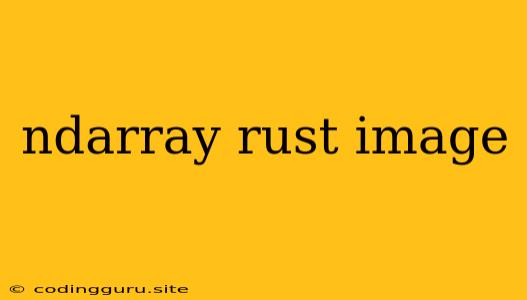Working with Images in Rust using ndarray
Rust is becoming increasingly popular for its speed, memory safety, and powerful features. When it comes to image processing, ndarray, a powerful multidimensional array library, can be a valuable tool. Let's explore how to work with images in Rust using ndarray.
Understanding the Basics
Before diving into the code, it's important to understand how images are represented in a computer. An image is essentially a grid of pixels, each pixel containing color information. This information is typically stored as a 2D array, where each element represents a pixel and its color.
Loading Images with Image Libraries
Rust doesn't have built-in image loading functionality. We'll need to leverage external libraries. Popular options include:
- image: A versatile library that supports various image formats.
- png: Dedicated to handling PNG images.
- jpeg: For working with JPEG images.
Let's look at an example of how to load an image using the image library.
use image::open;
fn main() -> Result<(), image::ImageError> {
let img = open("path/to/image.png")?; // Assuming "path/to/image.png" is the location of your image file.
// ... Further image processing ...
Ok(())
}
Converting Image Data to an ndarray
Once we have an image loaded, we need to convert it into an ndarray for manipulation. The image library provides a method to achieve this:
use image::open;
use ndarray::Array2;
fn main() -> Result<(), image::ImageError> {
let img = open("path/to/image.png")?;
let rgba_image = img.to_rgba8(); // Convert to RGBA format
let width = rgba_image.width();
let height = rgba_image.height();
let array: Array2 = Array2::from_shape_vec((height, width * 4), rgba_image.into_raw())?;
// ... Further image processing using ndarray ...
Ok(())
}
In this example, we first convert the image to RGBA format, which is a common representation for color images. Then, we create an ndarray of type u8 with dimensions corresponding to the image's height and width multiplied by 4 (for the R, G, B, and A channels).
Manipulating Images with ndarray
Now, we can use ndarray's powerful operations to manipulate our image data. Here are some examples:
-
Pixel Access: We can access individual pixels directly using indexing.
let pixel_value = array[(row, column * 4)]; // Accessing the red channel of the pixel at (row, column) -
Color Adjustments: Modify pixel values to change colors.
// Increase the brightness of the image for (i, pixel) in array.iter_mut().enumerate() { *pixel = (*pixel as f32 * 1.2) as u8; // Increase brightness by 20% } -
Filtering: Apply filters to smooth, sharpen, or blur the image.
// Simple averaging filter let kernel = Array2::from_shape_vec((3, 3), vec![1, 1, 1, 1, 1, 1, 1, 1, 1])?; let filtered_image = array.convolve(&kernel); -
Mathematical Operations: Apply mathematical operations like addition, subtraction, multiplication, and division.
// Multiply all pixel values by 2 let multiplied_image = array * 2;
Saving Modified Images
Once you've performed your image processing, you can save the modified image using the image library.
use image::save_buffer;
// ... After image manipulation using ndarray ...
let img = image::ImageBuffer::from_raw(width, height, array.as_slice().unwrap()).unwrap();
save_buffer(&img, "path/to/output.png", width, height, image::ColorType::RGBA(8))?;
Important Considerations
- Performance: While ndarray is efficient, image processing can be computationally intensive. Consider using optimized algorithms for faster processing.
- Image Formats: Be mindful of different image formats and their limitations.
- Memory Management: Handle memory effectively when working with large images to prevent memory leaks.
Conclusion
ndarray is a powerful tool for image processing in Rust, enabling efficient manipulation and analysis of image data. By combining ndarray with image libraries, you can build robust image processing applications in Rust.
